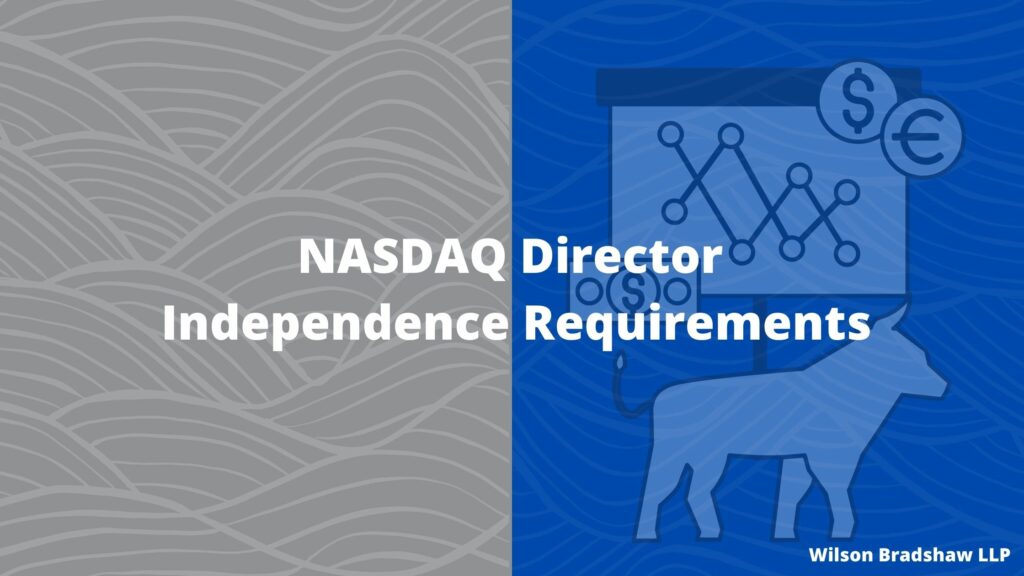The Nasdaq Stock Market requires its listed companies to meet certain standards that help ensure investor confidence in the listed companies. These requirements are intended to promote transparency, company prosperity, shareholder value, access to the capital markets, and overall market stability. They are also intended to guard against conflicts of interest, reduce fraud among public companies, facilitate uniform application of the rules, and ease administration. Among other requirements, the Nasdaq, under Rule 5605(b)(1), requires its listed companies to have a board of directors comprised of a majority of independent directors. It is important for investors to have confidence that individuals serving as independent directors do not have a relationship with the listed company that would impair their independence. This memorandum will outline the requirements for director independence and the consequences of noncompliance.
[/column_1] [column_1 width=”1/1″ last=”true” title=”” title_type=”single” animation=”none” implicit=”true”]Rule 5605(a)(2) – Definition of Independence
Rule 5606(a)(2) sets out the definition of “independent director.” An independent director means:
“a person other than an Executive Officer or employee of the Company or any other individual having a relationship which, in the opinion of the Company’s board of directors, would interfere with the exercise of independent judgment in carrying out the responsibilities of a director. For purposes of this rule, “Family Member” means a person’s spouse, parents, children, siblings, mothers and fathers-in-law, sons and daughters-in-law, brothers and sisters-in-law, and anyone (other than domestic employees) who shares such person’s home.”
The following persons would be considered not independent:
- A director who was employed by the company at any time during the past three years;
- A director who accepted, or who has a Family Member who accepted, compensation from the company in excess of $120,000 during any period of 12 consecutive months within the 3 years preceding the determination of independence, except the following three forms of compensation:
- Compensation paid to the director for board or board committee service;
- Compensation paid to a Family Member who is an employee (other than an Executive Officer) of the Company; OR
- Benefits under a tax-qualified retirement plan, or non-discretionary compensation
- A director who is a Family Member of an individual who is employed by the Company as an Executive Officer or was employed by the Company as an Executive Officer at any time during the past three years;
- A director who is, or has a Family Member who is, a partner in, or a controlling Shareholder or an Executive Officer of, any organization to which the Company made, or from which the Company received, payments for property or services in the current or any of the past three fiscal years that exceed 5% of the recipient’s consolidated gross revenues for that year, OR $200,000, whichever is more, other than the following:
- Payments arising solely from investments in the Company’s securities; OR
- Payments under non-discretionary charitable contribution matching programs.
- A director of the Company who is, or has a Family Member who is, employed as an Executive Officer of another entity where at any time during the past three years any of the Executive Officers of the Company served on the compensation committee of such other entity; OR
- A director who is, or has a Family Member who is, a current partner of the Company’s outside auditor, or was a partner or employee of the Company’s outside auditor who worked on the Company’s audit at any time during any of the past three years.
Note: the reference to the company includes any parent or subsidiary of the company. Parent or subsidiary is intended to cover entities the company controls and consolidates with the company’s financial statements as filed with the Securities and Exchange Commission.
Example of a Potential Director Conflict
For example, a director of the company is also a partner, controlling shareholder, or executive officer of a consulting firm to which the listed company made $150,000 in payments during one of the past three fiscal years. $150,000 does not exceed 5% of the recipient organization’s consolidated gross revenues. Because this $150,000 payment is less than both $200,000 and less than 5% of the recipient organization’s consolidated gross revenues, and because this $150,000 was not a direct payment to the director, that director is still considered an independent director. Essentially, this payment must exceed $200,000 if $200,000 is greater than 5% of the recipient organization’s consolidated gross revenues in order to disqualify the director from independent status. If $200,000 is less than 5% of the recipient’s consolidated gross revenues, then the payment must exceed that 5% threshold in order to disqualify the director from independent status.
Consequences of Non-Compliance
For companies listed on the Nasdaq Stock Market, there are consequences for non-compliance with the continued listing standards. The basic process is as follows:
- Nasdaq determines that the company has a deficiency in meeting the listing standards.
- Nasdaq will immediately notify the company of the deficiency. There are four types of deficiency notifications:
- Delisting Determinations, which are notifications of deficiencies that subject the Company to immediate suspension and delisting unless they are appealed;
- Notifications of a deficiency for which a company may submit a plan of compliance for Nasdaq review;
- Notifications of a deficiency for which a company is entitled to an automatic cure or compliance period; AND
- Public reprimand letters.
- The notification will:
- Inform the company as to the factual bases for the determination of deficiency or delisting, and the quantitative or qualitative standard the Company has failed to satisfy;
- Provide the company with the instructions for disclosing the deficiency under Nasdaq Listing Rules; AND
- Inform the company:
- in the case of a Nasdaq Delisting Determination, that the Company’s securities will be suspended as of a date certain; the Company has a right to request a review of the Delisting Determination by a Hearings Panel; and that a request for review within seven days will stay the suspension;
- in the case of a deficiency for which the Company may submit a plan of compliance for review by Nasdaq, the deadline by which a plan must be submitted;
- in the case of a deficiency for which the Company is entitled to an automatic cure or compliance period, the expiration date of the cure or compliance period; and
- in the case of a Public Reprimand Letter, an explanation of why Nasdaq concluded the letter is appropriate and the Company’s right to request review of the Letter by a Hearings Panel.
- A company is required to make a public announcement of the deficiency notification.
- For the director independence requirement, typically the company receives a notification of a deficiency for which the company may submit a plan of compliance for Nasdaq review.
- Company typically has 45 calendar days to submit a plan to regain compliance with Nasdaq listing standards. Nasdaq may extend this deadline up to 5 calendar days upon a showing of good cause.
- If the company fails to regain compliance within the time provided in a Nasdaq extension, the company will be subject to immediate delisting.
- There is an appeals process should the company decide to appeal a Nasdaq decision.
In general, on each trading day, Nasdaq will publish a list of companies that are non-compliant with the Nasdaq continued listing standards. Typically, a company is added to the list five business days after Nasdaq notifies the company about its noncompliance and is removed from the list one business day after Nasdaq determines that the company has regained compliance or no longer trades on Nasdaq. Non-compliance with listing standards, even temporarily, will almost certainly affect the market value of a listed company’s stock.
[/column_1]
